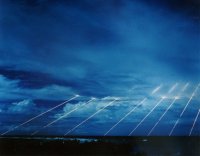Nuclear Doctrine, Strategy and Policy
 |
|
Eight re-entry vehicles (RVs) fly towards the ground after release from a single US Peacekeeper missile over the Kwajalein Atoll in the Pacific. The United States and Russia maintain thousands of nuclear weapon on alert, and more than 95 percent of the world's total inventory of nuclear weapons. Photo: US Army SMDC |
A decade and a half after the end of the Cold War Russia and the United States keep thousands of nuclear weapons, most with explosive force equivalent to hundreds of thousands of tons of TNT, ready to launch at a moment's notice. Yet we are near the end of a long process of having some nuclear weapons displaced by advanced conventional weapons.
Missions for Nuclear Weapons After the Cold War by Ivan Oelrich
The Director of the FAS Strategic Security Project analyzes 15 missions currently proposed for US nuclear weapons and finds that conventional weapons are preferred for almost all of them. The US can justify its vast arsenal only if it intends a first strike on Soviet nuclear forces. This FAS report argues for early US-Russian reductions in current forces and against starting a new generation of nuclear weapons including 'bunker-busters.'
STRATCOM Force Structure Studies
Nuclear Information Project Director Hans Kristensen examines half a dozen nuclear force structure studies completed by U.S. Strategic Command in the 1990s. Many of the conclusions and planning assumptions continue to influence U.S. nuclear forces and policy. Kristensen obtained the studies under the Freedom of Information Act (FOIA).
The 1994 Nuclear Posture Review
Kristensen analyzes a series of declassified documents from the Clinton administration's nuclear posture review in 1993-1994. The documents show the battle between the Office of the Secretary of Defense and the military services over the scope of the review. This collection of documents, which were obtained under FOIA, focus on the role of U.S. nuclear weapons against proliferators of weapons of mass destruction.
Sizing Post-Cold War Nuclear Forces
Oelrich's October 2001 paper published by the Institute for Defense Analyses Program PO-3650.
Try our NEW Bomb-A-City Calculator. Pick an American city. Pick the size of the bomb you wish to detonate virtually (1 kt to 4 MT). Choose your method of delivery (aircraft or automobile/suitcase). Then see the radius within which most buildings would be destroyed.

